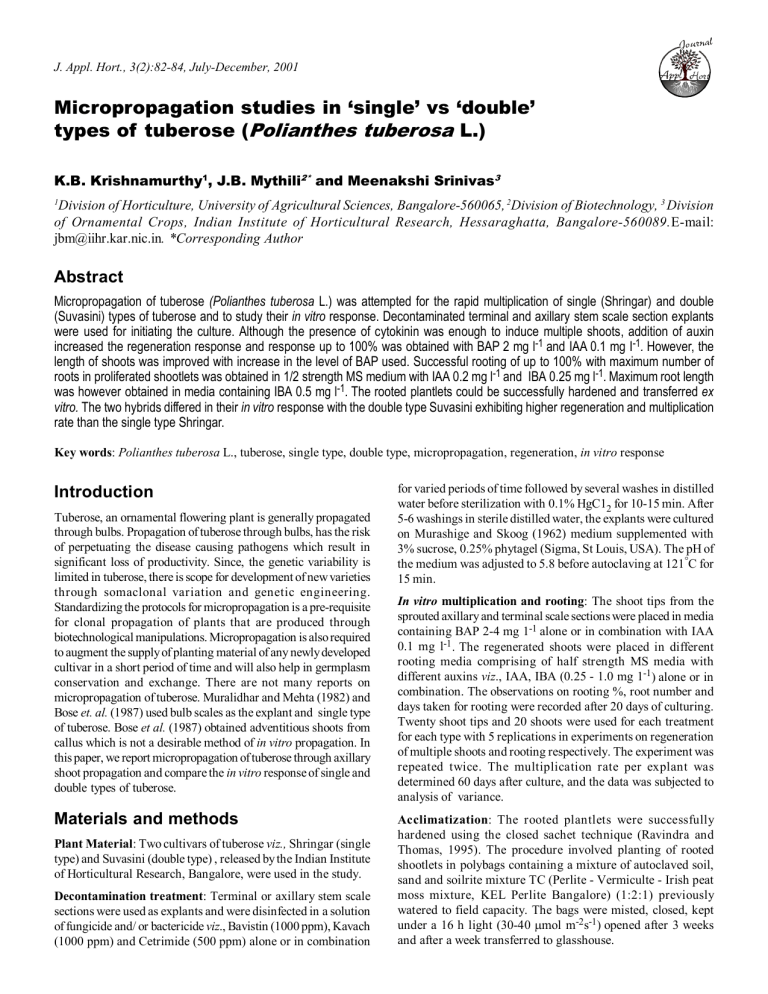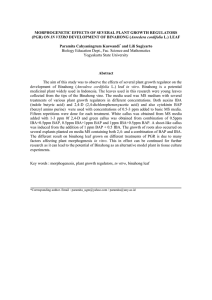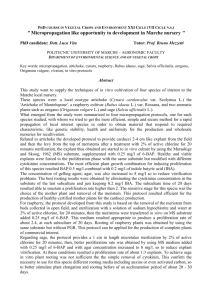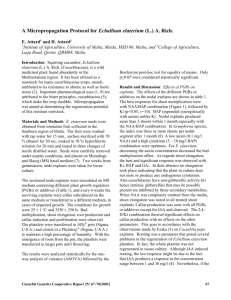
J. Appl. Hort., 3(2):82-84, July-December, 2001 Micropropagation studies in ‘single’ vs ‘double’ types of tuberose (Polianthes tuberosa L.) K.B. Krishnamurthy1, J.B. Mythili2* and Meenakshi Srinivas3 1 Division of Horticulture, University of Agricultural Sciences, Bangalore-560065, 2Division of Biotechnology, 3 Division of Ornamental Crops, Indian Institute of Horticultural Research, Hessaraghatta, Bangalore-560089.E-mail: jbm@iihr.kar.nic.in. *Corresponding Author Abstract Micropropagation of tuberose (Polianthes tuberosa L.) was attempted for the rapid multiplication of single (Shringar) and double (Suvasini) types of tuberose and to study their in vitro response. Decontaminated terminal and axillary stem scale section explants were used for initiating the culture. Although the presence of cytokinin was enough to induce multiple shoots, addition of auxin increased the regeneration response and response up to 100% was obtained with BAP 2 mg l-1 and IAA 0.1 mg I-1. However, the length of shoots was improved with increase in the level of BAP used. Successful rooting of up to 100% with maximum number of roots in proliferated shootlets was obtained in 1/2 strength MS medium with IAA 0.2 mg l-1 and IBA 0.25 mg l-1. Maximum root length was however obtained in media containing IBA 0.5 mg l-1. The rooted plantlets could be successfully hardened and transferred ex vitro. The two hybrids differed in their in vitro response with the double type Suvasini exhibiting higher regeneration and multiplication rate than the single type Shringar. Key words: Polianthes tuberosa L., tuberose, single type, double type, micropropagation, regeneration, in vitro response Introduction Tuberose, an ornamental flowering plant is generally propagated through bulbs. Propagation of tuberose through bulbs, has the risk of perpetuating the disease causing pathogens which result in significant loss of productivity. Since, the genetic variability is limited in tuberose, there is scope for development of new varieties through somaclonal variation and genetic engineering. Standardizing the protocols for micropropagation is a pre-requisite for clonal propagation of plants that are produced through biotechnological manipulations. Micropropagation is also required to augment the supply of planting material of any newly developed cultivar in a short period of time and will also help in germplasm conservation and exchange. There are not many reports on micropropagation of tuberose. Muralidhar and Mehta (1982) and Bose et. al. (1987) used bulb scales as the explant and single type of tuberose. Bose et al. (1987) obtained adventitious shoots from callus which is not a desirable method of in vitro propagation. In this paper, we report micropropagation of tuberose through axillary shoot propagation and compare the in vitro response of single and double types of tuberose. Materials and methods Plant Material: Two cultivars of tuberose viz., Shringar (single type) and Suvasini (double type) , released by the Indian Institute of Horticultural Research, Bangalore, were used in the study. Decontamination treatment: Terminal or axillary stem scale sections were used as explants and were disinfected in a solution of fungicide and/ or bactericide viz., Bavistin (1000 ppm), Kavach (1000 ppm) and Cetrimide (500 ppm) alone or in combination for varied periods of time followed by several washes in distilled water before sterilization with 0.1% HgC12 for 10-15 min. After 5-6 washings in sterile distilled water, the explants were cultured on Murashige and Skoog (1962) medium supplemented with 3% sucrose, 0.25% phytagel (Sigma, St Louis, USA). The pH of the medium was adjusted to 5.8 before autoclaving at 121°C for 15 min. In vitro multiplication and rooting: The shoot tips from the sprouted axillary and terminal scale sections were placed in media containing BAP 2-4 mg 1-1 alone or in combination with IAA 0.1 mg l-1 . The regenerated shoots were placed in different rooting media comprising of half strength MS media with different auxins viz., IAA, IBA (0.25 - 1.0 mg 1-1) alone or in combination. The observations on rooting %, root number and days taken for rooting were recorded after 20 days of culturing. Twenty shoot tips and 20 shoots were used for each treatment for each type with 5 replications in experiments on regeneration of multiple shoots and rooting respectively. The experiment was repeated twice. The multiplication rate per explant was determined 60 days after culture, and the data was subjected to analysis of variance. Acclimatization: The rooted plantlets were successfully hardened using the closed sachet technique (Ravindra and Thomas, 1995). The procedure involved planting of rooted shootlets in polybags containing a mixture of autoclaved soil, sand and soilrite mixture TC (Perlite - Vermiculte - Irish peat moss mixture, KEL Perlite Bangalore) (1:2:1) previously watered to field capacity. The bags were misted, closed, kept under a 16 h light (30-40 mol m-2s-1) opened after 3 weeks and after a week transferred to glasshouse. Krishnamurthy et al.- Micropropagation of ‘single’ and ‘double’ tuberose Results and discussion Decontamination of cultures: Decontamination of explants obtained from underground parts has been reported to be a very difficult task by several workers (Seabrook,1990, Hol and Vander Linde,1992).They partly solved the problem by very elaborate decontamination procedures including hot water treatment of bulbs, high concentration of decontaminants or by the use of fungicide containing media. We also encountered fungal contamination to be the major deterrent in aseptic culture establishment as there was no problem of bacterial contamination. However, Debergh and Maene (1981), have reported bacterial contamination as a major limitation in the establishment of aseptic culture. In the present study treatment with Bavistin (1000 ppm) + Kavach (500 ppm) + Cetrimide (500 ppm) overnight followed by HgC12 (0.1%) for 15 minutes was found to be effective in establishment of maximum per cent i.e., 26.6 and 30.0, 23.3 and 30.0 of axenic cultures in case of axillary and terminal stem scale sections of cvs ‘Shringar’ and ‘Suvasini’, respectively. This treatment helped to control fungal contamination totally. Dilta et al. (2000) used Bavistin, Dithane and HgC12 for sterilization in lilium. Multiple shoot induction : Terminal and axillary stem scale sections were used for the study and both the explants could be successfully established and proliferated. The response of both the explants was identical and hence both the explants were used. In general, almost all organs of bulbous plants have been shown to be able to regenerate plantlets, but the best suited ones were obtained from bulb scales, stems or bulbs (Vander Linde and Aartrijk, 1986). Earlier Bose et al. (1987), have also used stem scale sections for tuberose micropropagation. 83 Rumynin et al., 1990, Misra and Singh, 1999). Although the presence of cytokinin was found to be enough to induce multiple shoot proliferation, addition of auxin increased the regeneration response and response up to 100% with BAP 2 mg 1-1 and IAA 0.1 mg 1-1. The same treatment gave rise to maximum number Fig. 1 A B C D Fig. 2 Explants did not show any morphogenetic response in a media devoid of hormones. Generally cytokinins stimulate development of axillary buds whose growth is inhibited by apical dominance (Hussey, 1976 a,b) and it was effective in successful bud emergence from axillary buds of gladiolus corms (Hussey, 1977, Fig. 1a. Culture of terminal stem scale section of explant, 1b. Culture of shoot tip obtained from explant, 1c In vitro proliferation of shoots from shoot-tip culture and 1d. In vitro rooting of shoots. Fig. 2. Hardened plants established ex vitro Table 1. Regeneration response to the tuberose cv. Shringar and Suvasini, 60 Days after culturing S. Treatment Regeneration (%) Average Shoot number Average shoot length No (mg 1-1) Shringar Suvasini Mean Shringar Suvasini Mean Shringar Suvasini Mean 1 BAP 2.0 60.0 82.0 71.0 3.20 3.13 3.17 1.90 1.92 1.91 2 BAP 4.0 80.0 100.0 90.0 4.10 5.72 4.91 2.90 3.38 3.14 3 BAP2.0 + IAA 0.1 100.0 100.0 100.0 5.24 6.54 5.89 2.36 2.92 2.64 4 BAP4.0 + IAA 0.1 90.0 100.0 95.0 4.04 4.70 4.37 3.32 2.78 3.05 Mean(A) 82.5 95.5 4.15 5.02 2.62 2.75 CD (P=0.05) Variety (A) 3.1 0.22 NS Treatment (B) 4.3 0.31 0.29 AxB 6.1 0.44 0.41 Table 2. Rooting response of the tuberose cv. Shringar and Suvasini, 20 days after culture Sl. Treatment Rooting (%) Average root number Average root length(cm) No (mg 1-1) Shringar Suvasini Shringar Suvasini Shringar Suvasini 1 IBA 0.5 100 100 14.20 14.5 1.39 1.33 2 IBA 1.0 65 75 9.50 10.0 0.94 0.80 3 IAA 0.5 90 90 10.48 9.0 1.24 1.20 4 IAA 0.25 + IBA 0.25 100 100 16.70 15.8 1.30 1.30 5 MS Basal 0.0 0.0 0.0 0.0 0.0 0.0 SEM + 2.3 1.5 0.2 0.3 0.05 0.06 CD (p=0.05) 6.9 4.6 0.6 0.9 0.14 0.19 CV (%) 7.4 4.8 4.7 6.9 10.59 16.08 Days for rooting Shringar Suvasini 12 12 13 12 13 12 10 10 0 0 0.4 0.4 1.2 1.1 9.6 9.8 84 Krishnamurthy et al.- Micropropagation of ‘single’ and ‘double’ tuberose of shoots. The concentration of BAP was also critical as the number of shoots obtained is reduced significantly, while the length of the shoots increased significantly with the increase in BAP level 4 mg 1-1 used singly or in combination with IAA 0.1 mg l-1 (Table l and Fig lA-C). Regulation of both, organ differentiation and growth in tissue cultured plants by interplay of cytokinins and auxins has been reported by several workers beginning with Miller and Skoog (1957). The ratio of cytokinin to auxin used depends on the level of endogenous cytokinin present in the plant and thus varies with plant species used. However, there are species such as Lilium which did not require either plant growth regulators (Niimi, 1985). In the present study, variations in the response of two hybrids of tuberose viz., Shringar and Suvasini was noted. The double type (Suvasini) had significantly higher regeneration potential than the single type Shringar. The double type also gave rise to significantly higher number of shoots than the single type Shringar in all the hormonal treatments except with BAP 2mg 1-1. The better morphogenetic response in Suvasini (double type) may be related to the physiological differences in growth of the two types. There are hardly any reports on this aspect in the literature. However, differences in the morphological characters of single and double type have been reported by Bhattacharjee (1995). He states that the single type is characterized by more number of leaves (60-80), with greater spike length (90-120cm) as compared to double type which has 35-45 leaves and smaller spike length (75-95cm). Despite this, double type yields more number of flowers as compared to single type which may be related to the better translocation or utilisation of photosynthate necessary for the production of flowers (Mukhopadhyay and Nagaraju, 1988, Pathak et al., 1980). In vitro rooting: Use of auxins for root induction has been reported in several bulbous ornamentals. In this study, among different treatments tried, 100% root induction, early rooting and maximum number of roots (16.7 and 15.8) was obtained in half strength MS medium with IAA 0.25 mg 1-1 and IBA 0.25 mg 1-1 in Shringar and Suvasini respectively (Table 2 and Fig ld). Maximum root length (1.39 and 1.33) was obtained in media containing IBA (0.5 mg 1-1) in Shringar and Suvasini respectively (Table 2). Similar observations of maximum root length in media supplemented with IBA has been reported (Hussey et al., 1979) in Alstromeria. Better response of rooting observed in media containing IAA and IBA could be due to the synergistic effect of auxins. In Hippeastrum, it took 40 days to root on media containing IAA alone (Bose and Jana, 1977). Acclimatization: Both the cultivars could be hardened with100% survival using closed sachet technique (Fig 2). The presence of soilrite may have enhanced the survival rate due to optimum conditions of aeration, water holding capacity and nutrients present in this media. The hardened plants established with 100% success when transplanted to pots. Survival rate ranging from 60% in gladiolus (Ziv, 1979, Misra and Singh,1999) to 90% in hyacinth (Kim et al., 1981) has been reported. References Bhattacharjee, S.K. 1995. Cultural requirements of tuberose (pp757774). In K.L. Chadha and S.K. Bhattacharjee (eds.), Advances in Horticulture Vol 12 (Part2) Ornamental plants, Malhotra Publishing House, New Delhi. Bose, T.K. and B.K. Jana, 1977. Regeneration of plantlets in Hippeastrum in vitro. Indian J. Hort., 34:446-447. Bose, T.K, B.K. Jana and J. Moulik, 1987. A note on micropropagation of tuberose from stem scale sections. Indian J. Hort., 44:100-101. Debergh, P.C. and L.J. Maene, 1981. A scheme for commercial propagation of ornamental plants by tissue culture. Scientia Hort., 14:335-345. Dilta, B.S., O.P. Sehgal, B.P. Sharma and D.R. Sharma, 2000. In vitro multiplication of Lilium hybrids. Abstract, National Seminar on Hi-tech Horticulture June 26-28, Bangalore. pp34-35. Hol, G.M. and P.C.G. Vander Linde, 1992. Reduction of contamination in bulb explant cultures of Narcissus by a hot water treatment of parent bulbs. Plant Cell Tissue Organ culture, 31:75-80. Hussey, G. 1976a. In vitro release of axillary shoots from apical dominance in monocotyledonous plantlets. Ann Bot., 40:13231325. Hussey, G. 1976b. Plantlet regeneration from callus and parent tissue in Ornithogaluym thyrsoides. J. Exp. Bot., 27:375-382. Hussey, G. 1977. In vitro propagation of gladiolus by precocious axillary shoot formation. Scientia Hort., 6:287-289. Hussey, G, J. Milton and P. Lumsden, 1979. In vitro propagation of Alstroemeria. John.Inces. Institute, Seventeenth Annual Report. p 56. Kim, Y.J., P.M. Hasegawa and R.A. Bressan, 1981. In vitro propagation of hyacinth. Hort Sci., 16:645-647. Miller, C. O. and F. Skoog, 1957. Chemical regulation of growth and organ formation in plant tissue culture in vitro. Symp. Soc. Exptl. Biol., 11:118-130. Misra, S. and R. Singh, 1999. In vitro propagation of gladiolus Cv. American Beauty. J. Ornamental Horticulture, 2:67-70. Mukhopadhyay, A. and H.T. Nagaraju, 1988. Changes in growth, flowering and chemical composition of the tuberose “single”. Herbertia., 44:61-67. Muralidhar, C.E. and A.R. Mehta, 1982. Clonal propagation of three ornamental plants through tissue culture methods (pp.693-694). In A. Fujiwara. (ed) Plant Tissue Culture, Proc. 5 th Intl. Cong. Pl. Tissue & Cell Culture, Jap. Assoc. Plant Tissue Cult., Tokyo. Murashige, T. and F. Skoog, 1962. A revised medium for rapid growth and bioassay with tobacco tissue cultures. Physiol. Plant., 15:473479. Niimi, Y. 1985. Factors affecting the regeneration and growth of bulblets in bulbscale cultures of Lilium rubellum Baker. J. Jap. Soc. Hort. Sci., 54:82-86. Pathak, S., M.A. Choudhary and S.K. Chatterjee, 1980. Germination and flowring in different sized bulbs of tube rose (Polianthes tuberosa L.). Indian J. Plant Physiol., 23:47-54. Ravindra, M.B. and P. Thomas, 1995. Sachet technique- an efficient method for the acclimatization of micropropagated grapes (Vitis vinifera L.). Curr. Sci., 68:546548. Rumynin V.A., I.V. Agadzhanyan and A.G. Slyusarenko, 1990. Mass clonal propagation of gladiolus plants. In: Glavnogo Botanicheskogo Sada, USSR, Bull No. 156:6878. Seabrook, J.E.A. 1990. Narcissus (Daffodil). In: Ammirato, P.V, Evans, D.A, Sharp, W.R and Bajaj, Y.P.S (eds). Handbook of Plant Cell Culture vol V: Ornamental Species, McGraw-Hill Publishing Company, New York, pp577-597. Vander Linde, P.C.G. and V.J. Aartrijk, 1986. Micropropagation of flower bulb crops. In: Anderson, P.F, Dulforce, W.M (eds). Micropropagation in Horticulture, pp 123-134. Ziv, M. 1979. Transplanting gladiolus plant propagated in vitro. Scientia Hortic., 11:257-260.




